Our Welcoming Reception & 1st Waiting Area
Our Ground Floor Operatory
Our Ground Floor Operatory
Our Laboratory
Our Display Area With Updated Oral Hygiene Measures
Our First Floor Operatory
Our First Floor Operatory
RCT
Endodontics is a specialty of dentistry, that deals with the tooth pulp and tissues surrounding the root of a tooth. The pulp (containing nerves, arterioles and venules as well as lymphatic tissue and fibrous tissue) can become diseased or injured and thus is unable to repair itself. The pulp then dies and endodontic treatment is required. The word comes from the Greek words endo meaning inside and odons meaning tooth. Literally taken, it means study of that which is "inside the tooth".
Endodontists are Dentists who have specialized in this field. Typically they have completed an additional 3 years of training following dental school.
How Root Canals Work ?
Sometimes the pulp becomes infected. When this happens, it must be removed with root canal therapy. A root canal is the only way to save the tooth. A mature tooth can survive very well without the pulp. This saving of the tooth by RCT is done by your ENDODONTIST and this specialty is known as ENDODONTICS.
Tooth Anatomy
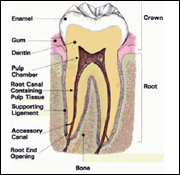
To understand how a root canal works, we need to have a basic understanding of the anatomy of the tooth. A tooth is hollow, like our bones, and is composed of several layers. The outermost layer (above the gum-line) is called the enamel. Enamel is the hardest and most mineralized substance in the body. Beneath the gum-line, a substance called cementum covers the tooth roots. Under the enamel and cementum is the dentin. The dentin is about as hard as bone, and, unlike the enamel, dentin contains nerve endings. Beneath the dentin is the dental pulp. The pulp is a vascular tissue, composed of capillaries, larger blood vessels, connective tissue, nerve fibers, and cells including odontoblasts, fibroblasts, macrophages, and lymphocytes. The pulp is needed to nourish the tooth during its growth and development. After a tooth is fully mature, the only function of the pulp is to let us know if it is damaged or infected by transmitting pain
FREQUENTLY ASKED QUESTION
- Q: How Does the Pulp become infected?
- Q: How will I know if I have an infected tooth?
- Q: If the tooth is infected, why can't I use an antibiotic to treat it?
- Q: What's involved in getting a root canal, and does it hurt?
- Q: Do different teeth have different numbers of root canals?
- Q: Can any dentist do a root canal?
- Q: How successful are root canals?
- Q: Why do some root canals fail, and how will I know?
- Q: What can I do if the root canal fails?
Still have questions?
Ask us for more information.
Q: How Does the Pulp become infected?
A: The most common way for the pulp to become infected is from an untreated cavity. A cavity is formed by acid in a rather unexpected way. Inside everyone's mouth is a legion of bacteria - they are completely normal and there is nothing you can do about them. Some of these bacteria metabolize (eat) carbohydrate-containing foods or beverages and make acid as a by-product. The acid is strong enough to eat through the enamel and dentin. If left untreated, it will eventually expose the underlying pulp to bacteria inside our mouths and it gets infected.
The pulp can also get infected from trauma to the tooth. A blow to a tooth can cut off the blood supply to the tooth from our jawbone, and cause the pulp tissue to slowly die. Interestingly, a tooth that breaks within the enamel and dentin during trauma is less likely to need root canal in the future because the fracture may absorb the trauma, sparing blood flow to the tooth.
A third way a tooth can become infected is if there is long standing periodontal (gum) disease around the tooth. Bacteria from the infected gums can enter the tooth through small opening on the root surface (accessory canals) and cause a retrograde infection. Whatever way the tooth becomes infected, the pulp eventually dies, and over time, will cause a painful dental abscess within the surrounding jawbone.
Q: How will I know if I have an infected tooth?
A: A tooth that becomes sensitive to hot or cold food or beverages or hurts when biting down may indicate an infected tooth. A tooth that becomes discolored or that causes the gums to swell around a tooth may also indicate a dental infection. In some cases, a tooth will have no symptoms, but a dental exam and x-ray will reveal a tooth that requires root canal.
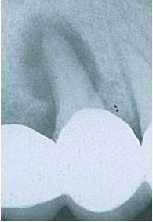
An infected tooth as seen in an x-ray. The dark circle around the root tip is an advanced dental abscess
Q: If the tooth is infected, why can't I use an antibiotic to treat it?
A: If a tooth has an infection of the pulp, the only options are root canal therapy or extraction. As the pulp dies, the hollow tooth becomes a reservoir for bacteria to hide from the body's immune system and any drugs that could fight the infection. In some cases a dentist will prescribe antibiotics during or after root canal therapy to kill bacteria within the jawbone and tissues surrounding the tooth, but recent research has shown that this is usually unnecessary.
Q: What's involved in getting a root canal, and does it hurt?
A: Root canal therapy is a complex procedure that requires both skill and experience. The dentist numbs the area of the infected tooth with local anesthesia. The tooth is isolated and prepared for the procedure.
A small hole is made through the enamel and dentin, and into the pulp. The pulp is then removed with small stainless steel files of increasing diameter. After the pulp has been removed, the inside walls of the roots are shaped, almost like a sculpture. Nickel/Titanium files that fit on a slow speed drill can aid in shaping the canals.
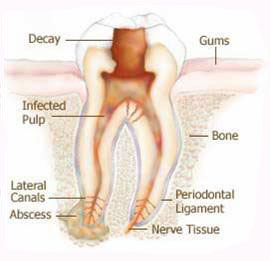
An infected tooth
During the procedure, fluids (irrigants) such as sodium hypochloride (bleach) and a compound containing ethylenediamine-tetraacetate (EDTA) are used to both kill remaining pulp tissue and bacteria within the roots, and remove dentin shavings produced by the files. After the pulp is removed and the inside of the roots shaped, the canal is dried with paper cones. The canal(s) are then filled with Gutta-percha. Gutta-percha is a miraculous substance that was first introduced by Bowman in 1867.
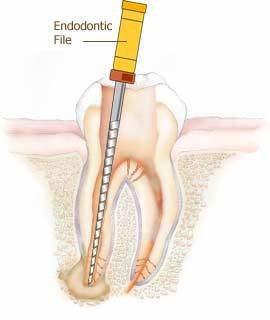
It is a purified form of Mazer Wood Trees indigenous to Indonesia and Malaysia that is combined with zinc oxide and other materials to form the rubbery filling that is placed into the tooth roots. The Gutta-percha is then cemented into the roots with a sealer that usually contains zinc oxide and eugenol. The goal of the filling procedure is to hermetically seal off the tooth against bacteria.
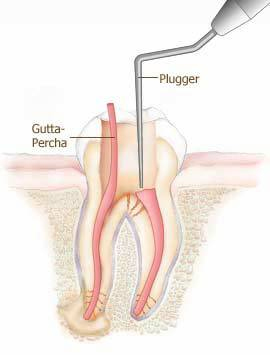
The tooth is filled with gutta-percha
Root canal therapy is usually not painful. With the effective use of anesthesia and modern techniques, most root canal therapy can be completed in one visit, and within one hour. A tooth will be sensitive for a few days after root canal therapy, and your dentist can prescribe you medication to alleviate the pain. In the meantime, do not eat on the side of the mouth that has the root canal for a few days.
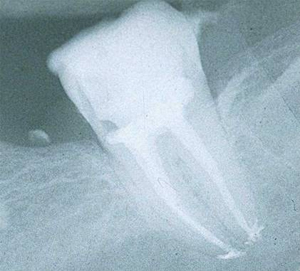
X-ray of a tooth filled with gutta-percha using the warm vertical condensation technique. Accessory canals are visible.
Q: Do different teeth have different numbers of root canals?
A: Teeth in the front of the mouth called incisors and canines usually have one root, and one nerve canal within the root. Teeth on the side of the mouth called premolars usually have one or two roots and one or two root canals. The upper back teeth (molars) usually have three roots, and three or four root canals. Lower back teeth (molars) usually have two roots and three or four root canals. Generally speaking, the more nerve canals the tooth has, the more complicated the root canal is to complete.
Q: Can any dentist do a root canal?
A: All dentists are trained to do root canals in dental school; however, skill levels and experience vary widely from dentist to dentist. An experienced general dentist can do almost all root canal therapy successfully, but some general dentists prefer to have a root canal specialist (an endodontist) perform root canal on their patients. And we are having very good endodontist Dr.Vidhyadhar Shetty to serve you best.
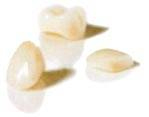
Q: How successful are root canals?
A: Root canals are successful about 90% of the time when they are done properly. Teeth that have had root canal can become brittle and are susceptible to fracture. In most cases, it is advisable to have a crown (cap) placed over a tooth that has had root canal to rebuild and protect it.
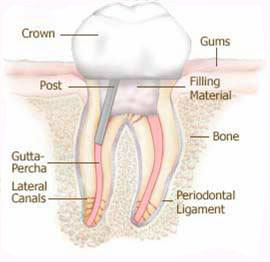
Crown is given after RCT
Q: Why do some root canals fail, and how will I know?
A: A tooth that has root canal can fail if some of the pulp is left inside the roots (a canal is missed), the gutta-percha does not completely seal off the tooth from bacteria, the tooth is damaged during the procedure (perforation), or the tooth fractures between the roots. In most cases, a tooth with a failing root canal will cause pain, usually when biting down.
Q: What can I do if the root canal fails?
A: In some cases, the root canal can be re-treated. The old gutta-percha filling is removed, the tooth is reshaped and cleaned, and then re-filled. If this is not possible, a procedure called an apicoectomy can be preformed. In an apicoectomy, the tip of the root is surgically removed, and a filling is placed over the cut root tip. If these measures fail, the tooth may have to be extracted.
